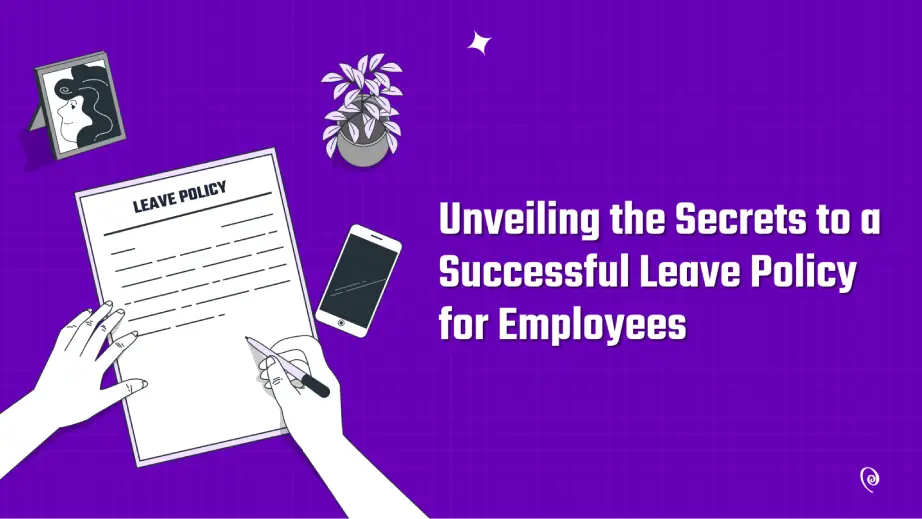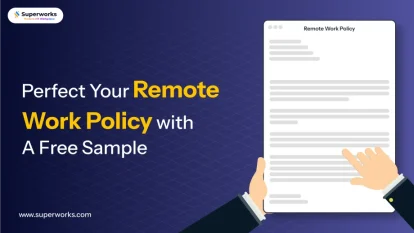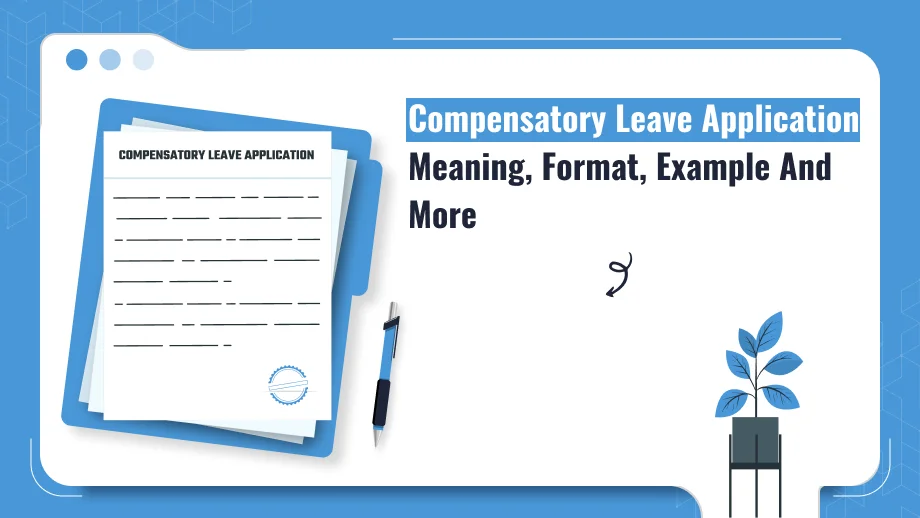Grab a chance to avail 6 Months of Performance Module for FREE
Book a free demo session & learn more about it!
-
Will customized solution for your needs
-
Empowering users with user-friendly features
-
Driving success across diverse industries, everywhere.
Grab a chance to avail 6 Months of Performance Module for FREE
Book a free demo session & learn more about it!
Superworks
Modern HR Workplace
Your Partner in the entire Employee Life Cycle
From recruitment to retirement manage every stage of employee lifecycle with ease.


Seamless onboarding & offboarding
Automated compliance & payroll
Track performance & engagement
Unveiling the Secrets to a Successful Leave Policy for Employees
- leave policy for employees sample
- 13 min read
- July 12, 2023

Did you know that an effective leave policy for employees can be a game-changer for every individual in an organization?
Picture a workplace where employee satisfaction soars, productivity flourishes, and burnout becomes a distant memory. This blog delves into the hidden secrets behind a successful leave policy, shedding light on the key ingredients that make it truly impactful and improve employee engagement like never before.
From the significance of work-life balance to the psychological benefits of time off, we explore how a well-crafted leave policy for employees can foster a thriving organizational culture.
Let’s dive into the blog and unlock the secrets to creating a leave policy for employees that empowers employees and propels businesses toward unprecedented success.
Note:You can download directly from here and edit as per your need.
What is a Leave Policy?
A leave policy for employees is a set of guidelines and procedures established by an organization to regulate employee time off from work. It outlines the various types of leaves available to employees, such as annual leave, sick leave, parental leave, and bereavement leave, along with the eligibility criteria, entitlements, and processes for requesting and approving leaves.
A well-defined employee leave policy ensures consistency, fairness, and transparency in managing employee absences, while also addressing legal requirements and protecting the rights of both employees and employers. It serves as a crucial tool for maintaining work-life balance, promoting employee well-being, and facilitating effective workforce management within an organization. Needless to say, a sample leave policy for employees in India can easily be found on the internet. Likewise, you can automatically manage the whole leave policy with a top-notch leave management system.
Different Types of Leave Policy
There are many but here are some of the most common leaves in the corporate world you must know about:
1. Annual Leave or Vacation Leave:
Annual Leave, also known as Vacation Leave, is a crucial component of a comprehensive leave policy. It grants employees a designated number of days off each year to rejuvenate, relax, and attend to personal matters.
Annual employee leave letter for office provides an opportunity for employees to take a break from work and maintain a healthy work-life balance. Whether it’s exploring new destinations, spending quality time with loved ones, or pursuing hobbies, this types of leave encourages employees to recharge and return to work with renewed energy and focus. By offering employees the chance to disconnect from work and enjoy personal time, annual leave application contributes to their overall well-being and job satisfaction.
2. Sick Leave:
Employee sick leave policy is a crucial element of a well-rounded leave policy, recognizing the importance of employee health and well-being. It allows employees to take time off work when they are ill or injured, ensuring they can prioritize their recovery without compromising their job security.
Sick Leave enables employees to rest, seek medical attention, and prevent the spread of contagious illnesses in the workplace. By providing this essential leave type, organizations demonstrate their commitment to the health and safety of their workforce. It promotes a positive work environment, reduces presenteeism, and helps employees maintain their physical and mental well-being. Moreover, joining report after leave contributes to higher productivity in the long run by allowing employees to fully recuperate before returning to work.
3. Parental Leave:
Parental leave is a vital aspect of a progressive leave policy, recognizing the significance of supporting employees during the transformative journey of becoming parents. It grants employees time off to bond with their new child, manage the responsibilities of parenthood, and adjust to the demands of a growing family.
Parental leave encompasses maternity leave for birth mothers, paternity leave for fathers or non-birth parents, and adoption leave for parents who adopt a child. By providing this leave, organizations acknowledge the importance of work-life balance, foster gender equality, and promote family-friendly practices. Parental leave enables employees to embrace their new roles as parents while ensuring job security and preserving the employer-employee relationship.
4. Casual Leave:
Casual leave, also known as personal leave, is a flexible type of leave that allows employees to take time off for unforeseen or personal reasons. It provides employees with the freedom to address urgent matters, handle personal appointments, attend to family emergencies, or deal with unexpected situations that require their immediate attention.
Casual leave is often granted without the need for prior notice or extensive documentation, allowing employees to take short breaks as needed. This type of leave acknowledges the importance of work-life integration and recognizes that employees may encounter unexpected events that require their presence or attention outside of regular work hours. By offering casual leave, organizations support their employees in maintaining a healthy work-life balance and accommodating unforeseen circumstances.
5. Leave Without Pay:
Leave without pay is a type of leave where employees take time off from work without receiving their regular salary or wages. It is typically granted for personal reasons that fall outside the scope of other leave categories or when employees have exhausted their available leave entitlements.
Leave without pay allows employees to temporarily suspend their work obligations while maintaining their employment status. However, it’s important to note that during leave without pay, employees may not accrue certain benefits, such as paid time off or contributions to retirement plans. Organizations may have specific guidelines and approval processes in place for granting leave without pay.
Read More – 5 Myths of Warning Letter Format

Want to design a leave policy for employees? We’ll help!
Choose Super HRMS for effortless management and tracking of employee leaves. Super HRMS empowers companies to create the most suitable and effective leave policies for their team within minutes.
So, if you do not want to miss out on the benefits of Super HRMS and then,
What is the Purpose of a Employee Leave Policy?
The purpose of a leave policy for employees is to establish clear guidelines and procedures for managing employee absences from work in a fair, consistent, and efficient manner. It serves several essential purposes within an organization.
Firstly, a leave policy ensures that employees are aware of their entitlements, rights, and responsibilities when it comes to taking time off. It provides a framework for employees to request leaves and for employers to evaluate and approve those requests. Need to mention, you can rely on the internet for an impressive employee leave letter format.
Secondly, an HR leave policy helps maintain smooth workflow and productivity by ensuring adequate coverage and planning for employee absences. It enables effective workforce management and minimizes disruptions caused by unplanned or excessive leaves.
Additionally, a leave policy promotes employee well-being, work-life balance, and job satisfaction by recognizing and addressing employees’ personal and health-related needs. It also ensures compliance with legal requirements and protects both employees’ rights and employers’ interests.
Overall, a well-crafted leave policy contributes to a positive organizational culture, employee engagement, and sustainable business operations.
The Importance of Leave Policy For Employees
A well-designed leave policy holds immense importance for employees, offering numerous benefits that contribute to their overall well-being and job satisfaction. Here are some key reasons why a leave policy is crucial for employees:
1. Work-Life Balance:
A leave policy for employees allows them to maintain a healthy work-life balance by providing them with dedicated time off from work. It acknowledges the importance of personal and family commitments, enabling employees to recharge, rejuvenate, and spend quality time with loved ones.
2. Physical & Mental Health:
Taking leave when needed supports employees’ physical and mental health. It allows them to rest, recover from illnesses, manage chronic conditions, and address personal well-being. Time off can alleviate stress, prevent burnout, and promote overall mental and emotional well-being.
3. Family Responsibilities:
A leave policy recognizes the significance of family responsibilities by providing specific leaves such as parental leave, allowing employees to bond with and care for their children, whether through childbirth, adoption, or fostering. It enables employees to be present during crucial milestones in their families lives.
4. Personal Development:
Leave policies often include provisions for personal or educational leaves, enabling employees to pursue professional development opportunities, attend workshops or conferences, or acquire new skills. Such leaves contribute to personal growth and enhance employees’ knowledge and expertise. That means employees can send a leave application without a pang of guilt or hesitation.
5. Flexibility and Support:
A well-defined leave policy for employees also offers them the flexibility to manage unexpected situations, emergencies, or personal commitments. It provides a support system that values their needs and helps them navigate challenging circumstances without fear of repercussions or job insecurity.
6. Legal Compliance & Protection:
A leave policy ensures compliance with labour laws and regulations, safeguarding employees’ rights. It protects them from potential discrimination, ensures fair treatment, and establishes transparent processes for requesting and approving leaves.
7. Job Satisfaction and Retention:
A comprehensive leave policy for employees enhances job satisfaction, fostering a positive work environment. It demonstrates that employers value their employees’ well-being and recognize the importance of work-life integration. This, in turn, promotes employee loyalty, engagement, and retention.
Who is Eligible for the Leave Policy?
The eligibility for a leave policy may vary depending on the organization and the specific leave type. However, in general, most leave policies extend to all regular full-time and part-time employees. This includes employees who have completed a certain period of service, typically satisfying a probationary period or meeting a specific employment tenure requirement.
Additionally, some leave policies may cover temporary or contract employees, but the entitlements and duration of leaves for such employees may differ from those of regular employees.
It is important for organizations to clearly define the eligibility criteria for each type of leave in their policy document. This ensures transparency and consistency in granting leaves, avoids misunderstandings, and helps employees understand their entitlements based on their employment status, length of service, and other relevant factors.
What are the Guidelines for the Leave Policy?
The guidelines for a leave policy for employees may vary depending on the organization and its specific needs. Nevertheless, take a look at ten important elements that you must include:
1. Types of Leave:
The leave policy for employees should outline the various types of leaves available to employees, such as annual leave, sick leave, parental leave, bereavement leave, and any other specific types relevant to the organization.
2. Eligibility & Entitlement:
Clearly define the eligibility criteria for each type of leave, including factors such as length of service, employment status, and any specific requirements. Specify the number of days or hours of leave entitlement for each type of leave.
3. Request & Approval Process:
Describe the procedure for requesting leave, including the preferred method of submission, the required notice period, and any documentation or supporting evidence needed. Outline the process for managers or supervisors to approve or deny leave requests, along with any backup or substitute arrangements.
4. Leave Calculation & Accrual:
If applicable, provide details on how leave is calculated and accrued. Specify whether leave is granted on a pro-rata basis for part-time employees and outline any rules or limitations related to leave carry-over or accumulation.
5. Communication & Record-Keeping:
Emphasize the importance of timely communication between employees and their managers or HR department regarding leave requests. Clearly state any record-keeping requirements, such as maintaining accurate leave balances and documentation for auditing or legal purposes.
6. Rights & Responsibilities:
Outline the rights and responsibilities of both employees and employers regarding leaves. This may include the obligation to follow the established leave procedures, the requirement to provide sufficient notice for planned leaves, and the responsibility to return to work on the agreed-upon date.
7. Return-to-Work Policy:
Specify any requirements or processes for employees returning from leave, such as providing a return-to-work notice or undergoing a reorientation or training program if necessary.
8. Confidentiality & Privacy:
Highlight the organization’s commitment to maintaining the confidentiality and privacy of employees’ personal information related to leave requests and medical documentation.
9. Legal Compliance:
Ensure that the leave policy for employees complies with applicable labor laws, regulations, and collective bargaining agreements. Include any necessary disclaimers or statements regarding the policy’s alignment with legal requirements.
10. Communication and Training:
Communicate the leave policy to all employees, making it easily accessible and providing opportunities for employees to seek clarification or ask questions. Offer training or educational materials to ensure employees understand their rights and responsibilities under the policy.
It is important for organizations to regularly review and update their leave policy to ensure it remains in line with evolving legal requirements, industry practices, and the changing needs of the workforce.
How can HRMS Manage Leave Policy for Employees?
Human Resource Management Systems (HRMS) can efficiently manage leave policies for employees by providing automated and centralized leave management processes. Here are some ways in which HRMS can facilitate leave policy management:
1. Leave Request & Approval:
HRMS allows employees to submit leave requests electronically, eliminating the need for manual paperwork. Managers can review and approve leave requests through the system, ensuring a streamlined and efficient process.
2. Leave Balances & Accruals:
HRMS tracks and maintains accurate leave balances for employees based on their entitlements and accrual rules. It automatically calculates accrued leave based on defined parameters such as length of service or employment status, reducing manual errors and ensuring consistency.
3. Calendar & Availability:
HRMS provides a centralized leave calendar that shows the availability of employees, making it easier for managers to plan and schedule work assignments. This helps prevent leave conflicts and ensures adequate coverage during employee absences.
4. Policy Compliance:
HRMS ensures that leave policies are applied consistently by automatically applying the organization’s predefined rules and guidelines. It helps enforce compliance with legal requirements, such as maximum leave durations or specific notice periods.
5. Reporting & Analytics:
HRMS generates reports and analytics related to leave data, such as leave utilization, trends, and patterns. This information enables HR professionals and managers to make informed decisions, identify potential issues, and optimize leave management strategies.
6. Integration with Payroll:
HRMS integrates with payroll systems, ensuring accurate calculation of leave-related salary deductions or payments. It streamlines the process of adjusting employee salaries based on their leaves, avoiding manual calculations and reducing errors.
7. Employee Self-Service:
HRMS provides employees with employee self-service portal where they can access their leave balances, submit leave requests, and view the status of their requests. This empowers employees with greater visibility and control over their leave-related information.
8. Notifications & Reminders:
HRMS sends automated notifications and reminders to employees and managers regarding upcoming leaves, leave approvals, and leave balances. In simpler words, HRs can automatically mail to employees for leave policy changes. This helps in ensuring timely communication and adherence to leave policies.
By leveraging HRMS for leave policy management, HR departments can save time, reduce administrative burdens, improve accuracy, and enhance employee satisfaction by providing a seamless and efficient leave management experience.
If you wish to design a leave policy in minutes, do not waste time searching for leave policy for employees in India pdf, leave policy for employees sample, or leave policy for employees in pvt ltd company, just invest in Super HRMS and do everything in a tap.
Parting Thoughts
In conclusion, a successful leave policy for employees goes beyond the mere provision of time off. It requires a thoughtful and strategic approach that prioritizes employee well-being, encourages work-life balance, and aligns with the organization’s objectives.
Now that you know the importance of a well-crafted leave policy, you can create a positive and productive work culture that attracts and retains top talent, leading to long-term success for employees, HRs, and the company as a whole.
Do not forget to check our HR toolkit for customizable policy templates and samples!














